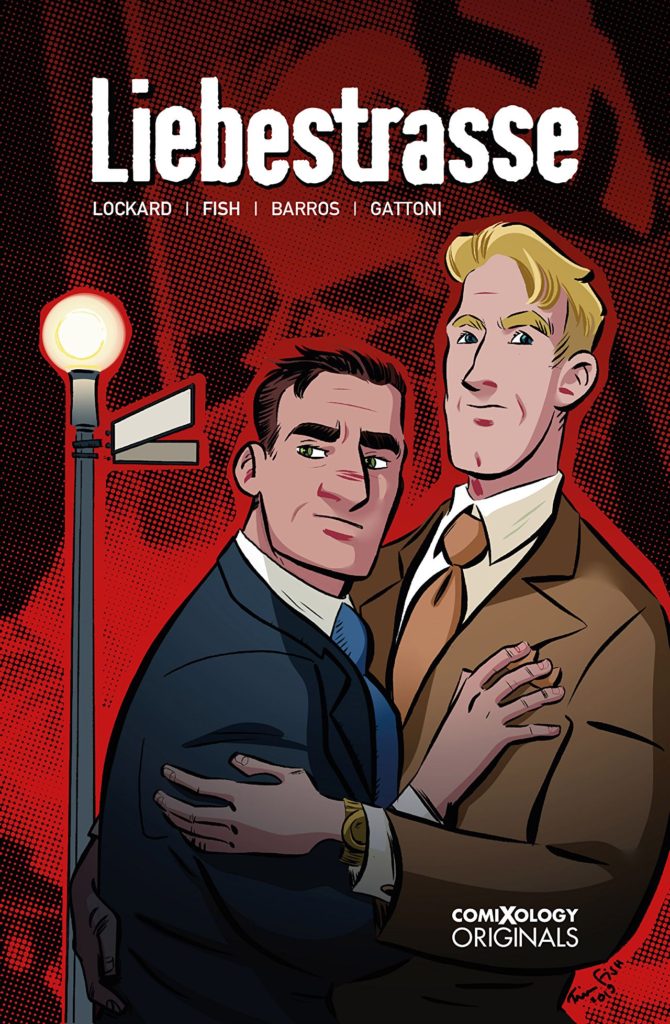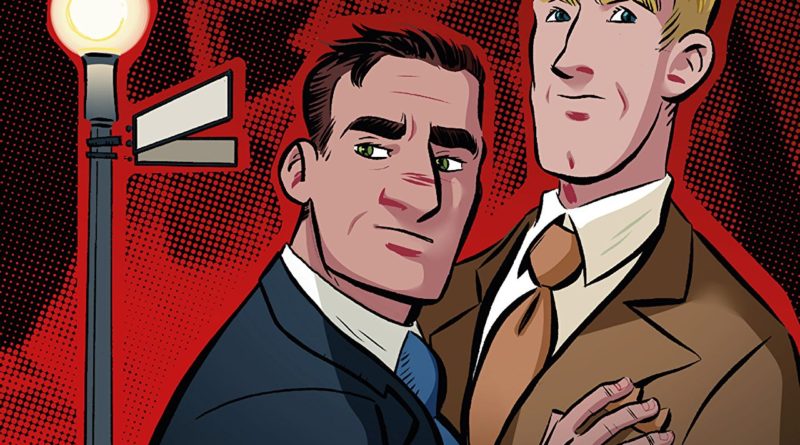INTERVIEW: ‘Liebestrasse’ is new LGBTQ graphic novel about finding love in fascist times
Image: Image courtesy of comiXology Originals / Provided by Superfan Promotions with permission.
The new graphic novel Liebestrasse, written by Greg Lockard and with art by Tim Fish, follows two men who fall in love in the 1930s during the rise of fascism in Germany. This story marks the graphic novel debut of Lockard and is part of ComiXology Originals, the digital comic service from Amazon.
The story follows an American banker named Sam and a German art critic named Philip. They are living together and working in Berlin when all of a sudden Philip is arrested and disappears. As Sam looks for his partner, the politics in the country begin to deteriorate, and the Nazis rise to power.
Lockard is a writer, editor and story consultant of comic books and graphic novels. He has interned at DC, worked at Valiant and now freelances in the comic industry. Fish is a comic book artist best known for Cavalcade of Boys, and his stories have been published by Marvel, Vertigo and other outlets.
Recently Hollywood Soapbox exchanged emails with Lockard and Fish about their work on Liebestrasse. Questions and answers have been slightly edited for style.
What inspired the creation of Liebestrasse?
Lockard: Tim approached me with the idea for a short story. He had the visuals for the first page (which eventually became page 71 of our graphic novel) and challenged me to write the story for him. There was enough going on in our world politically to motivate us both … and when we finished the short story, we had a significant amount of research and development in the characters and the city of Berlin at the time. An expansion into a long-form graphic novel seemed to make perfect sense.
Fish: About 10 years ago, I toured two very different concentration camps. Theresienstadt was a combination ghetto and camp, and the narratives of the people who lived there were well recorded. Reading them in the museum, I began reading between the lines as to which residents were gay. A week later I was at Auschwitz, one of the large death camps. There, the vast number of inhabitants could not be known as intimately. The museum was filled with large cases containing eyeglasses, or human hair, or shoes. Reflecting on the two visits, I couldn’t help but think what life would have been like living in a relatively liberal society one day, and the next, you’re interned. I let the idea sit in my head until the 2016 election. I felt like it was time to bring the story forward, and I asked Greg if he would write it for me based on the premise I had drawn in my sketchbook while I was in Poland.

How much research went into the time period and the treatment of the gay community in the 1930s?
Lockard: Much research went into the creation of this graphic novel, and there were numerous other texts — historical/non-fiction as well as fictional accounts — that filled out the research portion of this project. For the non-fictional and historical, the most important text was Robert Beachy’s Gay Berlin. It is a scholarly text that gave me invaluable insight into our characters’ world and the socio-political atmosphere in Germany at that time. It also provided the historical context for many of the ideas and events in our graphic novel. Gad Beck, Christopher Isherwood and Pierre Seel all wrote memoirs that were incredibly valuable as well.
Fish: Visually, I had researched a lot about this time period for other projects, such as Nazi uniforms, fashion and old cars. For this particular story, I was looking at period photography for the architecture.
How would you describe the character of Sam? What motivates him?
Lockard: I would describe Sam as a loving and kind person. He might be a bit conservative, but he was still curious and open-minded enough to explore the gay life in Berlin upon his arrival. He’s motivated by that need to love and be loved like anyone else.
Fish: I’d definitely describe him as the more cautious of the pair, but I agree, very loving.
Did it take a long time to settle on the artistic look of the graphic novel?
Lockard: Tim is a wonderful character designer, so he makes it look easy when it is not. Much of the look was dictated by the moments in history we represented, but we definitely also looked at many fictional portrayals in film, art and books to help us establish a greater artistic language for the story.
Fish: I tried out a few basic design concepts, one as serious as I could make it, one as cartoon-y as I thought the material would allow, and one that struck the middle, which we went with. Once we finished the short story version, we both agreed that the style was a good fit and accessible for readers not familiar with comics.
What was the collaboration like between the two of you?
Lockard: Tim and I have known each other for a long time at this point. We’ve collaborated a number of times on short stories, and while this is our first graphic novel together — we had a working relationship before starting this project that is pretty clear and honest. We know each other well, we can work in short-hand together and we have enough trust in each other to support as well as push each other further in our individual work. There’s a significant amount of discussion between the two of us about all aspects of the process, and we are one of the truest sets of co-creators I’ve experienced in my years of observing creative pairings in comics as an editor. Most importantly, without Tim’s confidence in my ability to write this story — this story wouldn’t exist.
Fish: I found the collaboration fast-paced and exciting. It was an aggressive timeline, and we both knew that we had to stay nose-to-the-grindstone to hit it. I think we were able to check our egos at the door and just kept working. We live in different places, but fortunately in the same time zone, making regular check-ins easier. And we also had three in-person retreat weekends, which were really helpful in working through the script and production challenges.
Could you comment on the vitalness and importance of having diverse characters from the LGBTQ community in the pages of comic books and graphic novels? Is there still a lot of work to be done on this front?
Lockard: Representation truly matters, and I know this firsthand. There are many recent examples of comic books and graphic novels’ further expansions into diversity, and it’s very inspiring! But there is still much work to be done, and it is a driving force behind significant choices I’ve made in my career thus far. I hope to continue to tell stories for and by the LGBTQ community and help make space for other people to represent themselves in comic books and graphic novels as well.
Fish: There’s work to be done everywhere, but certainly in the work of comics. That said, as a creator, it’s also challenging to be all things to all people. But there are LGBTQ people in the world, in reality, and they should be present in comics.
By John Soltes / Publisher / John@HollywoodSoapbox.com
Liebestrasse, written by Greg Lockard and with art by Tim Fish, is now available from comiXology Originals. Click here for more information.

